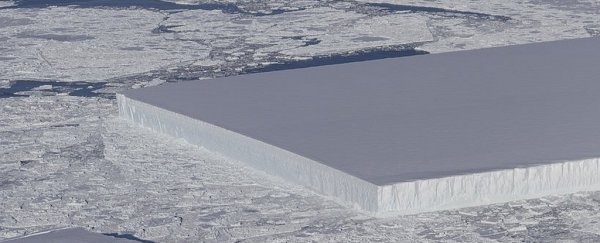Nature is messy. It's often geometric, but also riotous and irregular and asymmetrical.
Rarely will you see straight edges or 90-degree angles - so when these things show up in a natural environment, it looks really, really weird.
Take this iceberg NASA photographed in Antarctica last week as part of Operation IceBridge. Sitting amid a chaotic jumble of floating ice, it looks perfectly rectangular, as though it was deliberately cut.
But you can relax. There are no ice-cutting aliens out there, snickering over the hilarious practical joke they're playing on unsuspecting humans, nor is there a secretive group of humans in Antarctica with massive saws cutting ice for nefarious unknown reasons.
That 'berg is perfectly natural.
When we think of icebergs, we tend to think of huge chunks of ice with pointy spires and domes, with its bulk extending down below the surface of the water. But these are just one of two kinds of iceberg classified by shape, called non-tabular icebergs.
Tabular icebergs, by contrast, look more like this rectangular 'berg. They're large slabs of ice with nearly vertical sides and a flat top, and they often form by calving off ice shelves.
University of Maryland Earth scientist Kelly Brunt told LiveScience that you can think of it a little bit like a fingernail growing too long and cracking off at the end - this calving often results in perfect, straight, geometric lines.
And these tabular icebergs can be enormous - hundreds or even thousands of square kilometres, such as the 11,000 square kilometre (4,200 square mile) B-15, the largest iceberg ever recorded.
From yesterday's #IceBridge flight: A tabular iceberg can be seen on the right, floating among sea ice just off of the Larsen C ice shelf. The iceberg's sharp angles and flat surface indicate that it probably recently calved from the ice shelf. pic.twitter.com/XhgTrf642Z
— NASA Ice (@NASA_ICE) October 17, 2018
This new one hasn't been measured, and it's difficult to gauge its size from just this photograph, but it's not even nearly approaching that size.
It looks, in fact, like a relative shrimp compared to some of its larger kin - although it is likely over 1.6 kilometres (1 mile) across, Brunt told LiveScience.
A chunk of the deteriorating Antarctic Larsen C ice shelf, it seems to have calved very recently, based on its very clean edges - the sea and wind haven't yet been to work eroding them.
Straight, geometric lines aren't uncommon in tabular icebergs, which tend to break along natural cracks and crevasses in the ice, a process accelerated by warmer temperatures as meltwater trickles into and widens the cracks.
It's also worth noting that we can't see the other side of the iceberg in this photo - it may be very irregular, which would probably make the iceberg look a lot less peculiar.
